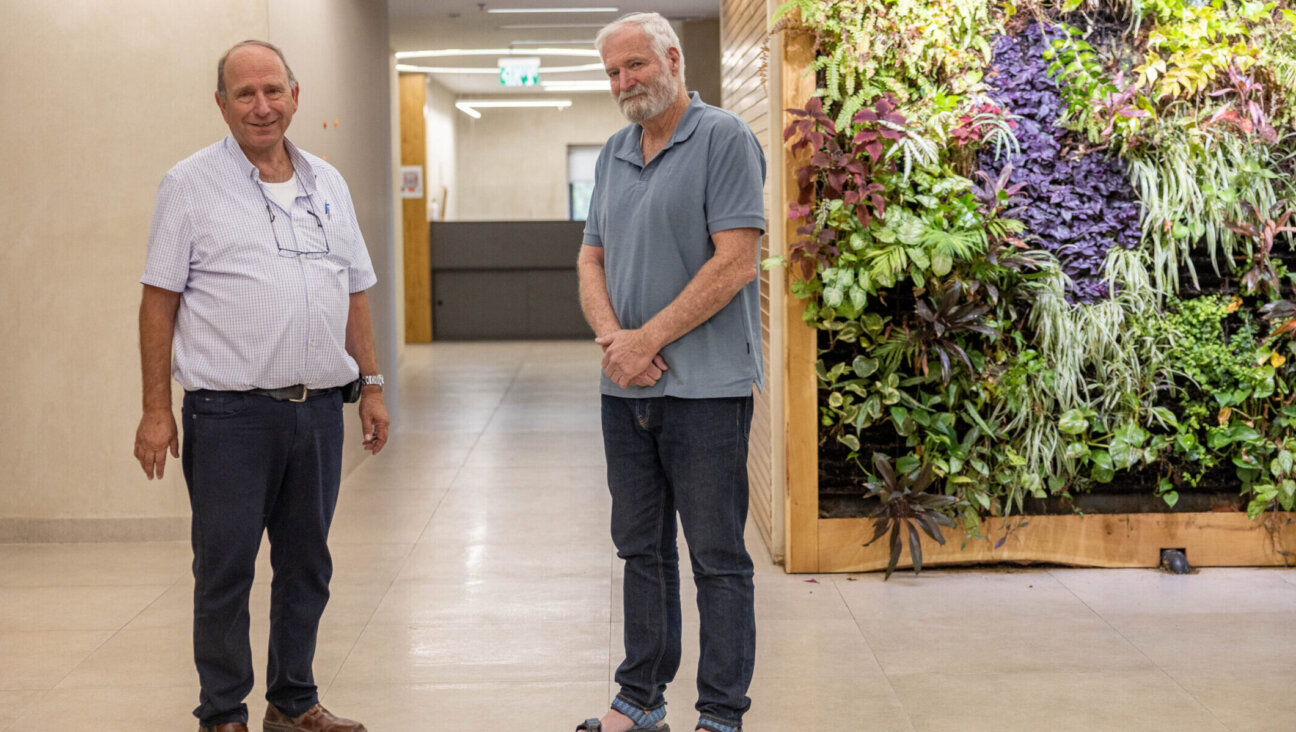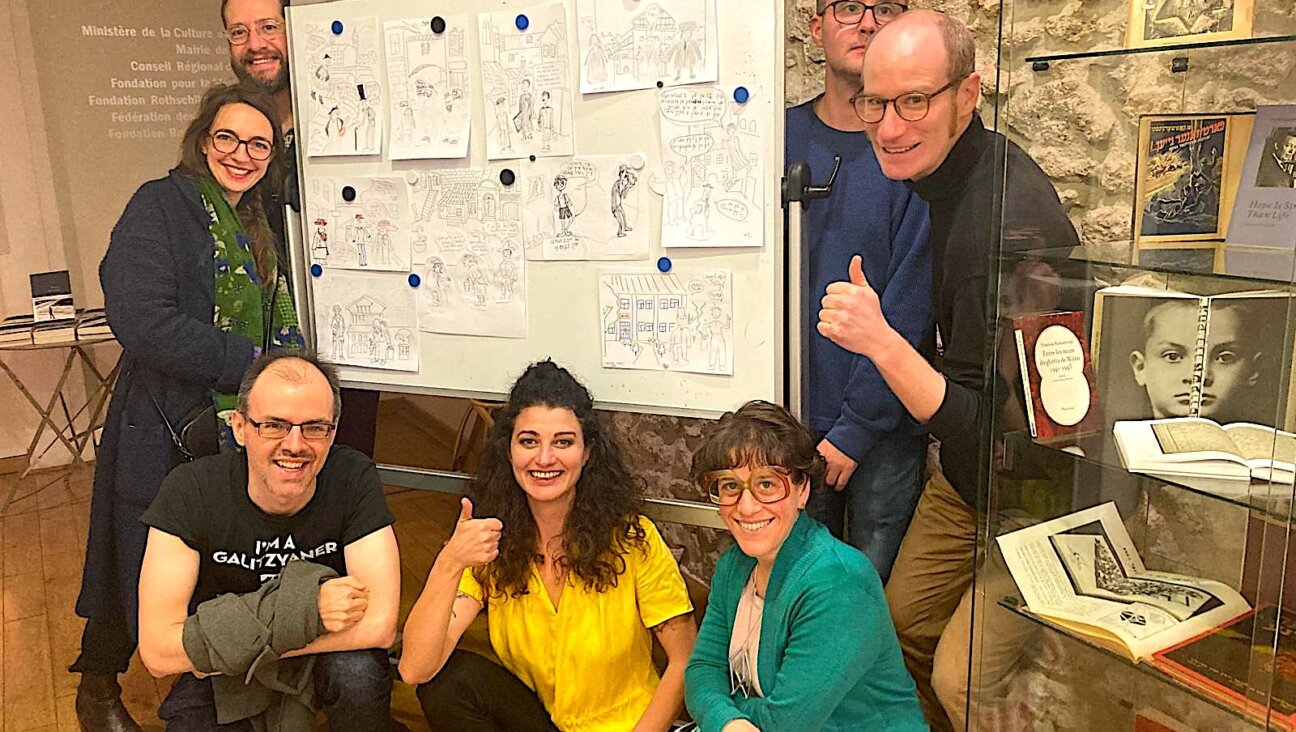Avant-garde Painter Constructs Bridges Across the Diaspora
For his 1966 painting “Kibbutz Composition,” artist José Gurvich crowded the canvas with layers of muted colors and boldly outlined images. At first, the kinetic composition tells of the artist’s zeal for kibbutz life. Look at it a little longer, and the story expands beyond the kibbutz; it moves into Latin America, where Gurvich’s hand was trained, and into the Lithuanian shtetl of the artist’s childhood fantasies.
Many of the paintings in the new retrospective, “José Gurvich: Constructive Imagination,” work this way: What initially appear as singularly themed paintings quickly reveal themselves as palimpsests. Gurvich spent his life moving around — Lithuania, Uruguay, Israel, Uruguay, New York — sharpening his artistic vision within myriad cultures. Individually and collectively, the works at his show reflect his desire to bridge different places and cultures, creating a body of work emblematic of the 20th-century Diaspora.
The exhibit, Gurvich’s first in New York, is the centerpiece of Tradition and Transformation: Jewish Culture in Latin America. The Americas Society, a nonprofit organization dedicated to promoting understanding within the Americas, sponsors the series. Gabriella Rangel, director of visual arts at the Americas Society, said they decided to organize the series because they thought many Americans were not aware of the Jewish presence in Latin America, let alone of the great artistic achievements attributed to the group. With this theme in mind, Gurvich seemed like the most natural choice.
“He needed to be reconsidered,” she said. “Gurvich was part of a group who collaborated in creating a modern avant-garde in Latin America, and then found a new voice in the kibbutz and in New York. He was the export of that period.”
Most of the art in the show came from private collectors, with a few pieces coming from the Museo de Arte Latinoamericano de Buenos Aires in Argentina. Gurvich’s art was very popular during his life, and he was more likely to sell his art to individuals than to organize shows or exhibits at institutions. Today Gurvich is little known outside of South America, where he is remembered as a leading artist of the Constructivist movement.
Gurvich was born in Lithuania in 1927, but he spent only six years there before his family relocated to Montevideo, the capital of Uruguay. Unlike other Latin American countries at the time, the Uruguayan government held a sharp division between the Catholic Church and the state, making it easier for Jews to hold on to tradition. Gurvich’s mother taught her children religious customs, as well as Yiddish, providing the artist with a Jewish background that became a leitmotif in his work.
The Sabbath table, the menorah, and the Jewish star appear in many of the pieces at the exhibit — sometimes in Chagallesque compositions done in Israel, and other times in modernist sculptures done in New York. Together the 41 works in the exhibition reveal the breadth of the artist. Works like “Construction in White and Black” and “Structure With Figures” appeal to those who have more modern tastes, while “World of the Kibbutz” and “New York Collage” lean more toward surrealism.
Originally interested in music, at 16 Gurvich enrolled in violin class, where he met the son of Joaquín Torres-Garcia, founder of constructive universalism and the Torres-Garcia Workshop. Within a year, Gurvich relinquished his musical ambitions and joined the Torres-Garcia Workshop. He adopted elements of constructive universalism in his art: muted color schemes, simple backgrounds, geometric organization and lots of symbols. But even then, Gurvich has an independent edge, an imaginative style, which increased throughout his life.
Soho gallery owner Cecilia de Torres, daughter-in-law of Torres-Garcia, is curating the current show. De Torres is considered the foremost expert on Gurvich’s work, and she was excited to curate a show that revealed his fusion of Torres-Garcia’s theories with Jewish culture.
“I think there is a humor in Gurvich’s work that has to do with the irony and down-to-earth humor that Yiddish has,” she said.
In “Constructive Composition,” a painted wood block done in 1962, the artist follows the constructivist teachings but uses them to create his own language. Gurvich does this by painting a simple, pre-Columbian-type figure in black and white and then filling it in with the symbols that define him — the sun, men, women, a menorah, the Star of David, an apple and an eye.
“The symbols were an affirmation of his identity,” de Torres said. “He always held on to his Jewish identity.”
The retrospective covers the last 20 years of Gurvich’s life, including painting and sculpture from the time he spent moving back and forth between Kibbutz Ramot Menashe in northern Israel and Montevideo. Also featured are a number of works from the time that Gurvich spent in New York, from 1970 until he died in the city of a heart attack in 1974.
As the overwhelming urban landscapes on his canvases suggest, Gurvich had a difficult time feeling at home in New York. Obstacles included the lack of interest in Latin American art at the time, as well his inability to speak English. His command of Yiddish turned out to be a saving grace, and it was through this language that he was able to chat with neighbors and do his food shopping on the Lower East Side.
In 1965, after a romp through Greece witnessing what he considered truly classical art, Gurvich told de Torres that he realized his limitations as an artist. He believed that there was such a thing as universal beauty, classical art, but knew he would never be able to produce it.
“My art might never align itself with a truly classical spirit because I am not a classicist. I know that unlike Torres [Garcia], I don’t even aspire to it,” Gurvich once wrote in his personal papers. “But the truth is that I am not a romantic either because it is impossible to work without rules. Well let’s not put a name to it. I am what I am: something without a name.”
“José Gurvich: Constructive Imagination” is a retrospective of this art without a name — an art that is not from one place, one time or one culture. There is no singular concept informing the work, no classic vision communicated. There is, though, the work of an artist who was open to it all — the past, present and future of all the places he inhabited — and who, through sundry layers and cheeky juxtapositions, created art out of what he, and so many others, saw.
Elissa Strauss is a writer and film producer living in New York City.
A message from our CEO & publisher Rachel Fishman Feddersen

I hope you appreciated this article. Before you go, I’d like to ask you to please support the Forward’s award-winning, nonprofit journalism during this critical time.
We’ve set a goal to raise $260,000 by December 31. That’s an ambitious goal, but one that will give us the resources we need to invest in the high quality news, opinion, analysis and cultural coverage that isn’t available anywhere else.
If you feel inspired to make an impact, now is the time to give something back. Join us as a member at your most generous level.
— Rachel Fishman Feddersen, Publisher and CEO























